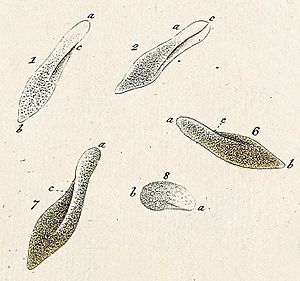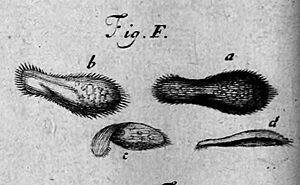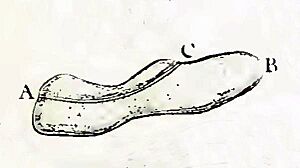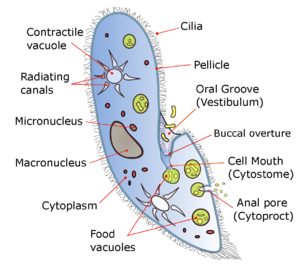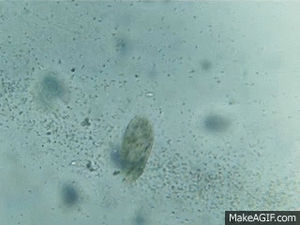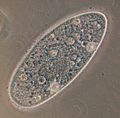Paramecium facts for kids
Paramecium (pronounced PARR-uh-MEE-shee-um) is a group of tiny, single-celled living things. They are so small you need a microscope to see them! These amazing creatures are a type of ciliate, which means they have tiny hair-like structures called cilia all over their bodies.
You can find Paramecium almost everywhere there's fresh water, like in ponds, puddles, and even some salty water. They are often called "slipper animalcules" because many of them look like the bottom of a slipper. Scientists often study Paramecium in classrooms and labs because they are easy to grow and help us learn about how living things work. They are like the "white rats" of the ciliate world!
Contents
Discovering Paramecium: A Look Back
Paramecium was one of the first tiny creatures ever seen by people using microscopes. This happened way back in the late 1600s! A Dutch scientist named Antonie van Leeuwenhoek probably saw them. Another scientist, Christiaan Huygens, clearly described them in a letter in 1678.
The very first drawing of a Paramecium was published in a science paper in 1703. Later, in 1718, a French teacher named Louis Joblot drew a tiny "fish" he found in water with oak bark. He called it "Chausson," which means "slipper" in French. That's how Paramecium got its nickname, the "slipper animalcule," which people used for a long time!
The actual name "Paramecium" comes from a Greek word meaning "oblong" or "longish." An English scientist named John Hill first used this name in 1752. Then, in 1773, Otto Friedrich Müller officially placed Paramecium into the system we use to name living things.
What Does a Paramecium Look Like?
Paramecium cells can be different sizes, from very tiny (about 50 micrometers) to a bit larger (up to 330 micrometers). To give you an idea, a micrometer is one-millionth of a meter! Most Paramecium look like an oval, a foot, or even a cigar.
The outside of a Paramecium cell is covered by a strong but flexible skin called the pellicle. This pellicle has a pattern of tiny hexagons or rectangles. Each one has a small hole where a single cilium (a tiny hair) sticks out.
Most Paramecium also have special defense tools called trichocysts. These are like tiny harpoons that can shoot out thin threads. They use them to protect themselves from danger.
On the bottom side of the cell, there's a spot called the anal pore where waste leaves the cell. There's also a deep groove called the oral groove that runs from the front of the cell to the middle. This groove is lined with cilia that constantly beat, sweeping food into the cell.
Paramecium mainly eat other tiny organisms like bacteria. Some types of Paramecium are special because they have tiny green algae living inside them. These algae make food using sunlight, and the Paramecium gets some of that food.
Paramecium have special parts called contractile vacuoles. These act like tiny pumps, pushing extra water out of the cell. This is important because water is always trying to get into the cell from its surroundings.
How Paramecium Moves
A Paramecium moves by using its cilia, which are arranged in neat rows all around its body. Imagine tiny oars all working together! Each cilium moves in two steps: a fast "power stroke" that pushes the water, and then a slow "recovery stroke" where it bends back into position.
All the cilia work together in waves, like wind blowing across a field of grass. This makes the Paramecium spin as it swims through the water.
If a Paramecium bumps into something, it quickly changes direction! Its cilia reverse their beat, and the Paramecium swims backward for a short time. Then it tries to move forward again. This is called the avoidance reaction. If it hits the object again, it will repeat this until it finds a clear path.
Moving around takes a lot of energy for a Paramecium. In fact, more than half of its energy is used just for swimming!
How Paramecium Finds Food
Paramecium love to eat tiny things like bacteria, algae, and yeasts. To get food, they use their cilia to create a current of water. This current sweeps the food into their oral groove.
From the oral groove, the food goes into a narrower space called the buccal cavity. Then, the food particles pass through a small opening called the cytostome, or "cell mouth," and enter the main part of the cell.
As food enters, it gets collected into little bubbles called food vacuoles. These vacuoles then move around inside the cell in a circular motion. This movement helps mix the food with special chemicals called enzymes, which digest the food.
As the food is digested, the vacuole gets smaller. Once all the useful nutrients have been taken out, the vacuole moves to the anal pore. There, it opens up and releases the waste outside the cell.
Paramecium and Friends: Symbiosis
Some types of Paramecium live in helpful partnerships with other organisms. For example, Paramecium bursaria has tiny green algae living inside it. The algae make food, and the Paramecium gets some of that food. In return, the algae get a safe place to live inside the Paramecium. This kind of partnership is called mutualism.
Paramecium can also have different kinds of bacteria living inside them. Some of these bacteria, called Kappa particles, give the Paramecium a special power: they can kill other Paramecium that don't have Kappa particles!
How Paramecium Reproduces
Like all ciliates, Paramecium has two main parts inside its cell that control everything:
- The macronucleus is like the main control center. It handles all the daily jobs the cell needs to do to stay alive.
- The micronucleus is like the cell's "blueprint" or genetic storage. It holds the genetic information that gets passed on to the next generation.
Paramecium usually reproduces by simply splitting into two new cells. This is called binary fission, and it's a type of asexual reproduction. It means the cell makes an exact copy of itself.
During this process, the macronucleus divides, and the micronuclei also make copies. Then, the whole cell splits in half, and each new cell gets a copy of both the macronucleus and the micronucleus. This way, two new Paramecium are formed from one!
Sometimes, Paramecium can also "mate" in a process called conjugation. In this process, two Paramecium of different types temporarily join together and swap some genetic material. This doesn't directly make more Paramecium, but it helps them mix up their genes, which can make them stronger and more adaptable over time.
Aging in Paramecium
Even tiny single-celled organisms like Paramecium can show signs of aging! When Paramecium reproduce by simply splitting (asexual reproduction), their "clones" (exact copies) can gradually lose their strength and vitality over time.
Scientists have found that after about 200 times of splitting, some Paramecium cells start to get old and might even die if they don't go through the "mating" process (conjugation or autogamy) to refresh their genetic material.
Research has shown that the aging process in Paramecium is linked to damage in their DNA, especially in the macronucleus. This is similar to how aging happens in more complex living things, including humans!
Types of Paramecium
There are many different kinds of Paramecium! Here are some of them:
- Paramecium primaurelia
- Paramecium biaurelia
- Paramecium triaurelia
- Paramecium tetraurelia
- Paramecium pentaurelia
- Paramecium sexaurelia
- Paramecium septaurelia
- Paramecium octaurelia
- Paramecium novaurelia
- Paramecium decaurelia
- Paramecium undecaurelia
- Paramecium dodecaurelia
- Paramecium tredecaurelia
- Paramecium quadecaurelia
- Paramecium sonneborni
- Paramecium buetschlii
- Paramecium bursaria
- Paramecium calkinsi
- Paramecium caudatum
- Paramecium chlorelligerum
- Paramecium duboscqui
- Paramecium grohmannae
- Paramecium jenningsi
- Paramecium multimicronucleatum
- Paramecium nephridiatum
- Paramecium polycaryum
- Paramecium putrinum
- Paramecium schewiakoffi
- Paramecium woodruffi
Images for kids
See also
 In Spanish: Paramecio para niños
In Spanish: Paramecio para niños


